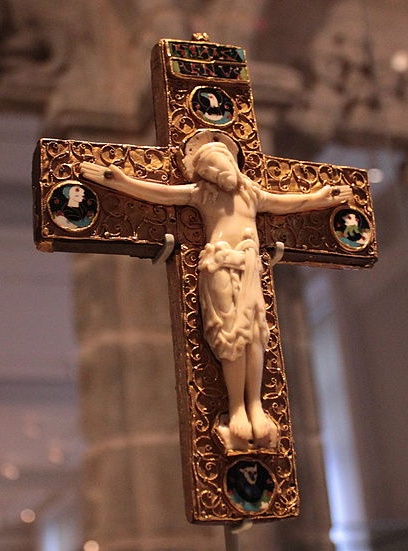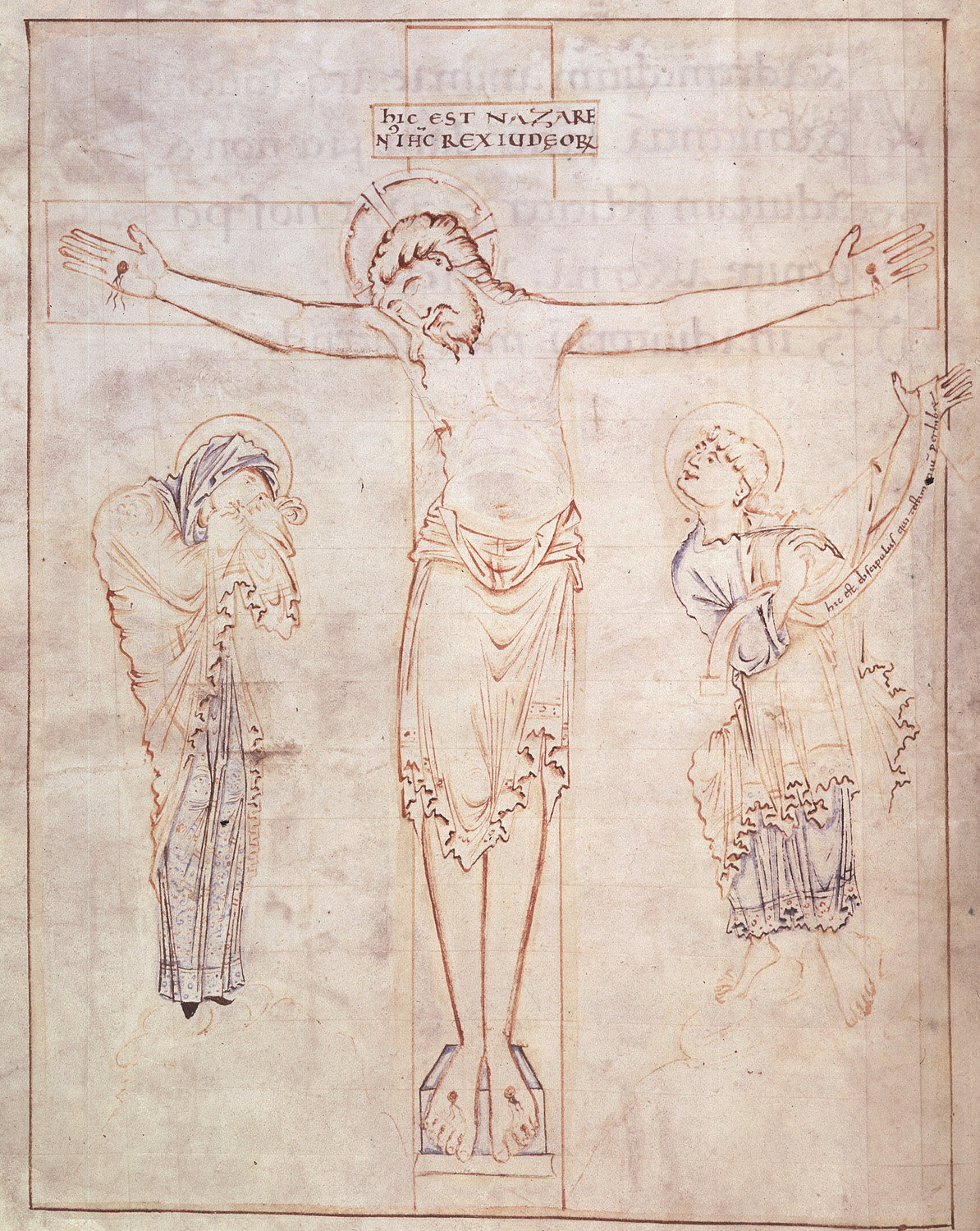Anglo-Saxon reliquary cross on:
[Wikipedia]
[Google]
[Amazon]

 The Reliquary Cross is a late 10th-century
The Reliquary Cross is a late 10th-century
V&A page, with more photos
and bibliography * ''Otto der Grosse: Magdeburg und Europa'', herausgegeben von Matthias Puhle (Mainz, 2001) pp 434–436 Cat no. VI. 27 * Williamson, Paul (ed.), ''The Medieval Treasury'', London: V&A Publications, 1998, p. 96 * Mitchell, H.P, ''English or German ? - A Pre-Conquest Gold Cross'', Burlington Magazine XLVII 1925, p 324 * Williamson, Paul. ''Medieval Ivory Carvings. Early Christian to Romanesque.'' London, V&A Publishing, 2010, pp. 238–241, cat.no. 60 * Wilson, David M.; ''Anglo-Saxon Art: From The Seventh Century To The Norman Conquest'', Thames and Hudson (US edn. Overlook Press), 1984.

 The Reliquary Cross is a late 10th-century
The Reliquary Cross is a late 10th-century Anglo-Saxon
The Anglo-Saxons were a Cultural identity, cultural group who inhabited England in the Early Middle Ages. They traced their origins to settlers who came to Britain from mainland Europe in the 5th century. However, the ethnogenesis of the Anglo- ...
ivory figure of Christ, set on an earlier Ottonian
The Ottonian dynasty (german: Ottonen) was a Saxons, Saxon dynasty of List of German monarchs, German monarchs (919–1024), named after three of its kings and Holy Roman Emperors named Otto, especially its first Emperor Otto I, Holy Roman Empe ...
cross to make a reliquary
A reliquary (also referred to as a ''shrine'', by the French term ''châsse'', and historically including ''wikt:phylactery, phylacteries'') is a container for relics. A portable reliquary may be called a ''fereter'', and a chapel in which it i ...
in the form of a crucifix
A crucifix (from Latin ''cruci fixus'' meaning "(one) fixed to a cross") is a cross with an image of Jesus on it, as distinct from a bare cross. The representation of Jesus himself on the cross is referred to in English as the ''corpus'' (Lati ...
. It is in the Victoria and Albert Museum
The Victoria and Albert Museum (often abbreviated as the V&A) in London is the world's largest museum of applied arts, decorative arts and design, housing a permanent collection of over 2.27 million objects. It was founded in 1852 and nam ...
(V&A) in London (Cat. 7943-1862, usually on display in room 8, case 16, in the "Medieval and Renaissance" gallery).V&A
The cross is made of cedar wood
Cedar is part of the English common name of many trees and other plants, particularly those of the genus ''Cedrus''.
Some botanical authorities consider the Old-World ''Cedrus'' the only "true cedars". Many other species worldwide with similarl ...
and covered with plates of gold filigree
Filigree (also less commonly spelled ''filagree'', and formerly written ''filigrann'' or ''filigrene'') is a form of intricate metalwork used in jewellery and other small forms of metalwork.
In jewellery, it is usually of gold and silver, ma ...
work. The ''corpus'' or figure of Christ, was probably made in Winchester
Winchester is a City status in the United Kingdom, cathedral city in Hampshire, England. The city lies at the heart of the wider City of Winchester, a local government Districts of England, district, at the western end of the South Downs Nation ...
, and is in walrus ivory
The walrus (''Odobenus rosmarus'') is a large flippered marine mammal with a discontinuous distribution about the North Pole in the Arctic Ocean and subarctic seas of the Northern Hemisphere. The walrus is the only living species in the fami ...
; the titulus and medallions are in cloisonné enamel
Cloisonné () is an ancient technique for decorating metalwork objects with colored material held in place or separated by metal strips or wire, normally of gold. In recent centuries, vitreous enamel has been used, but inlays of cut gemstones ...
, and apparently also English. The body of the reliquary, because of a technical "trick" in the gold filigree, is thought to be German, around the same date, probably from the area of Aachen
Aachen ( ; ; Aachen dialect: ''Oche'' ; French and traditional English: Aix-la-Chapelle; or ''Aquisgranum''; nl, Aken ; Polish: Akwizgran) is, with around 249,000 inhabitants, the 13th-largest city in North Rhine-Westphalia, and the 28th- ...
and Essen
Essen (; Latin: ''Assindia'') is the central and, after Dortmund, second-largest city of the Ruhr, the largest urban area in Germany. Its population of makes it the fourth-largest city of North Rhine-Westphalia after Cologne, Düsseldorf and D ...
.
The V&A says "the cross is one of the rare surviving pieces which give substance to descriptions in contemporary documentary sources of the sumptuous church furnishings of pre-Conquest England. The enamels are unique in Anglo-Saxon art
Anglo-Saxon art covers art produced within the Anglo-Saxon period of English history, beginning with the Migration period style that the Anglo-Saxons brought with them from the continent in the 5th century, and ending in 1066 with the Norma ...
and may have been made by an English goldsmith familiar with German work. The wood core of the cross was perhaps regarded as a relic
In religion, a relic is an object or article of religious significance from the past. It usually consists of the physical remains of a saint or the personal effects of the saint or venerated person preserved for purposes of veneration as a tangi ...
of the True Cross
The True Cross is the cross upon which Jesus was said to have been crucified, particularly as an object of religious veneration. There are no early accounts that the apostles or early Christians preserved the physical cross themselves, althoug ...
. It is most unlikely because of its size and weight, that it was made to be worn as a pectoral cross
A pectoral cross or pectorale (from the Latin ''pectoralis'', "of the chest") is a cross that is worn on the chest, usually suspended from the neck by a cord or chain. In ancient and medieval times pectoral crosses were worn by both clergy and ...
and more probable that the suspension loop allowed it to hang above an altar or shrine."
Description
The body of the cross is of cedar wood, covered with sheets of gold, the back with repousse decoration now badly crumpled and flattened, the front decorated with filigree work, enamels and an ivory ''corpus'' of Christ. This is carved in walrus ivory. Haloed and crowned, the bearded Christ wears an elaborately pleated loin-cloth, knotted through the folded girdle. The head leans towards the right shoulder and the long hair falls in several plaits onto the shoulders. The figure is held in place by golden nails through the palms. The titulus above Christ and four medallions with symbols of the four Evangelists are of cloisonné enamel. The back of the cross shows theLamb of God
Lamb of God ( el, Ἀμνὸς τοῦ Θεοῦ, Amnòs toû Theoû; la, Agnus Dei, ) is a title for Jesus that appears in the Gospel of John. It appears at John 1:29, where John the Baptist sees Jesus and exclaims, "Behold the Lamb of God wh ...
and the emblems of the Evangelists in repoussé or beaten work.
The height of the cross is 18.5 cm, the width 13.7 cm, the depth 2.6 cm, the weight 0.22 kg. The height of the figure is 12.2 cm, the width 10.9 cm.
In 1926, during cleaning work, a human finger, perhaps female, was found in a cavity underneath the corpus. A fragmentary and not totally legible inscription around the edge of the cross seems to list the relics of saints once contained in the cavity beneath the ivory figure of Christ.
: 'IHS NAZARENUS'
: RE(LIQVIE LIGNI) ....VLQ DE...O ET CAMIN....(IHS.XPS) AMD NIS//RV....EDA....DI....DI SIMEONIS ET MAR
Despite Papal disapproval of the dismemberment of saints, a finger relic was by no means unusual in Anglo-Saxon England: King Athelstan bestowed one third of his extensive collection of relics to the monastery of St Mary and St Peter at Exeter
Exeter () is a city in Devon, South West England. It is situated on the River Exe, approximately northeast of Plymouth and southwest of Bristol.
In Roman Britain, Exeter was established as the base of Legio II Augusta under the personal comm ...
in AD 932. The gift included a finger, purportedly that of Mary Magdalene
Mary Magdalene (sometimes called Mary of Magdala, or simply the Magdalene or the Madeleine) was a woman who, according to the four canonical gospels, traveled with Jesus as one of his followers and was a witness to crucifixion of Jesus, his cru ...
.
David Wilson points to the close similarity between the figure on the cross and that in a tinted drawing in the Ramsey Psalter
The Psalter of Oswald also called the Ramsey Psalter (British Library, Harley MS 2904) is an Anglo-Saxon illuminated psalter of the last quarter of the tenth century. Its script and decoration suggest that it was made at Winchester, but certain ...
, dated 980-1000.Wilson, 194-195
Notes
{{ReflistReferences
V&A page, with more photos
and bibliography * ''Otto der Grosse: Magdeburg und Europa'', herausgegeben von Matthias Puhle (Mainz, 2001) pp 434–436 Cat no. VI. 27 * Williamson, Paul (ed.), ''The Medieval Treasury'', London: V&A Publications, 1998, p. 96 * Mitchell, H.P, ''English or German ? - A Pre-Conquest Gold Cross'', Burlington Magazine XLVII 1925, p 324 * Williamson, Paul. ''Medieval Ivory Carvings. Early Christian to Romanesque.'' London, V&A Publishing, 2010, pp. 238–241, cat.no. 60 * Wilson, David M.; ''Anglo-Saxon Art: From The Seventh Century To The Norman Conquest'', Thames and Hudson (US edn. Overlook Press), 1984.
Reliquary
A reliquary (also referred to as a ''shrine'', by the French term ''châsse'', and historically including ''wikt:phylactery, phylacteries'') is a container for relics. A portable reliquary may be called a ''fereter'', and a chapel in which it i ...
Ivory works of art
Pendant crosses
Reliquary crosses